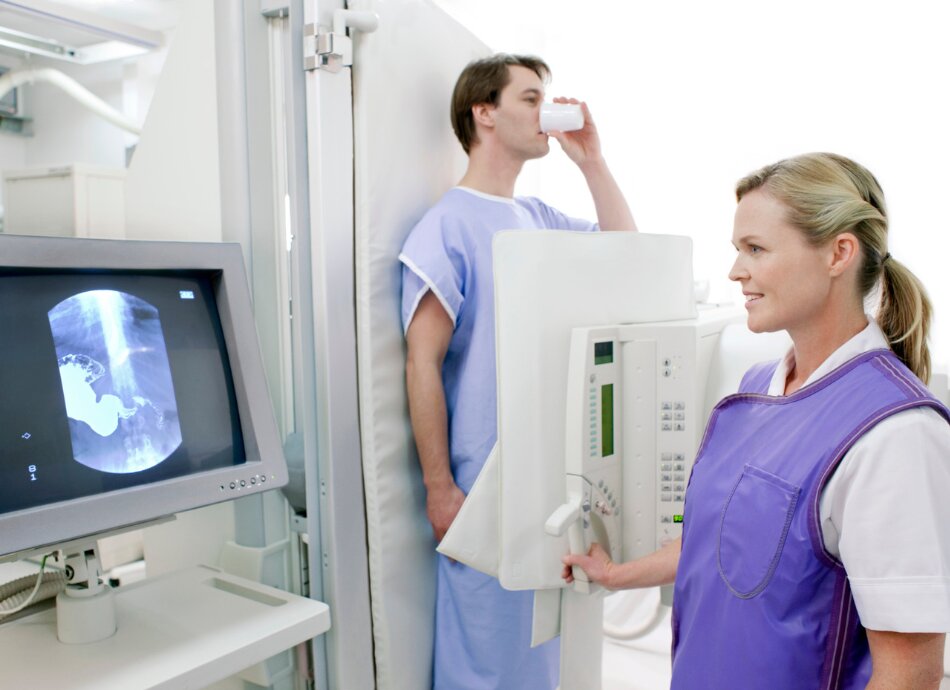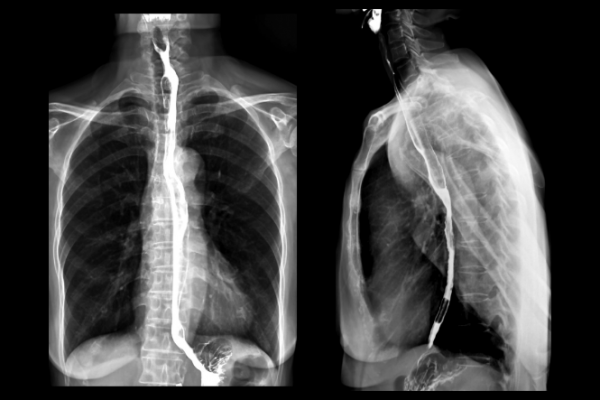Wishing everyone happy holidays and a joyful New Year from the Healthify team. Don't forget to Slip, Slop, Slap and Wrap!
Barium swallow and barium meal
Key points about barium swallow
- A barium swallow or a barium meal is an X-ray that is taken during or after you have swallowed a substance called barium.
- It's done so that parts of your body show up better on the X-ray.
- Barium is a chalky substance that shows up well on X-rays.
- As you swallow it the barium coats the lining of your throat and oesophagus, and afterwards the inside of your stomach and upper bowel can also be seen on X-ray.
- It may be done if you have trouble swallowing or have stomach pain or frequent vomiting.

A barium swallow or a barium meal (also called an oesophagogram) is an x-ray that is taken during or after you have swallowed a substance called barium. Barium is a chalky liquid that shows up well on x-rays. A barium swallow gives a clear picture of the back of your throat and the tube that leads to your stomach (your oesophagus) as you are swallowing. A barium meal shows your stomach and the upper part of your bowel after you have swallowed the barium. Often a barium meal x-ray is taken straight after the barium swallow. As barium passes down your throat and through your stomach it outlines their shape and also their movement.

Image credit: Canva
Why might I need a barium swallow/meal?
You may be asked to have a barium swallow or meal if you are having trouble swallowing or if you have unexplained stomach pain or frequent vomiting. Sometimes babies or children need to have a barium swallow or meal. To find out more about this test for your baby or child visit the Starship Website here(external link).
What can a barium swallow/meal show?
A barium swallow or meal can identify conditions such as:
- reflux (gastro-oesophageal reflux disease or GORD)
- muscle disorders or spasms in your throat or stomach
- constriction in your throat or oesophagus
- ulcers of the throat or stomach
- hiatus hernia (hernia at the top of your stomach)
- structural problems of the throat or stomach or upper bowel
- benign or malignant tumours or lumps in the throat or stomach.
A barium swallow or meal can be done as part of a series of scans, tests or x-rays that look at the whole of your throat, stomach and upper bowel area. Some of these additional tests may include a gastroscopy.
A barium swallow or meal is done by a radiology team. This is a team that specialises in x-rays and scans. The team will ask you not to eat or drink anything from a set time on the day before the test. This will probably include not taking your medicines. Make sure you have clear instructions on how to manage your medicines before this test. If you have diabetes you may need advice from your diabetes or GP team on how to manage your diabetes before and during your barium swallow or meal.
You will be asked to change into a hospital gown and to remove any jewellery, hair clips, or clothes containing metal that will be within the x-ray field. You may be given a lead shield or apron to wear over your pelvic area. If you wear dentures you may also be asked to remove these.
You will stand, sit, or lie on an x-ray table. You may be told to change positions during the test. You will be given a drink containing barium. It is like a thick milkshake and is often flavoured with chocolate or strawberry. X-rays will be taken either as you swallow, or after you swallow, or both. The radiologist can see the barium moving down your throat and into your stomach. You may be given a fizzy drink to inflate your stomach and sometimes you may be given a small injection to slow down the movements of your stomach. Both of these can help to give a better picture.
A barium swallow or meal usually takes about 30–60 minutes. Normally you can resume your usual activities afterwards, although you may want to take it easy for the rest of the day. You can eat normal food after the test, but barium can make you constipated so it is important that you drink at least 3 litres of water each day for the next 3 days. This will help to flush the barium through your system and help your bowels to move normally. Your bowel motions will be light coloured for several days. Let your doctor know if you don't have a bowel motion within 3 days after the test. You may need help to get them moving normally again.
The results of the barium swallow or meal will be sent to the doctor who referred you for the test. Make sure you arrange a follow up appointment with this doctor to discuss the results.
These are safe tests as the dose of radiation is very low. However if you are pregnant, or think you may be pregnant, let your doctor and the radiology team know. Even low dose radiation can be harmful to an unborn child. The team can then discuss other options with you.
Barium swallows or meals are often done at the radiology department of public hospitals. Your GP will refer you. There is sometimes a waiting list for these tests.
Many private radiology services also offer barium swallows or meals. To have the test done privately your doctor will need to refer you. For further information and support, talk to your doctor or contact the hospital or radiology centre where you are having the barium swallow or meal.
Barium swallow(external link)(external link) Johns Hopkins Medicine, US
References
Barium swallow(external link)(external link)(external link) Johns Hopkins Medicine, US
Barium swallow(external link)(external link)(external link) National Library of Medicine, US
Having a barium swallow(external link)(external link)(external link) NHS, UK, 2016
Barium swallow/meal(external link)(external link)(external link) Capital & Coast District Health Board, NZ, 2018
Gastrointestinal Radiology (imaging the oesophagus, stomach, small bowel and colon)(external link)(external link)(external link) Starship Child Health, NZ
Credits: Healthify editorial team. Healthify is brought to you by Health Navigator Charitable Trust.
Reviewed by: Louise Farmer, Clinical Nurse Specialist
Page last updated:





